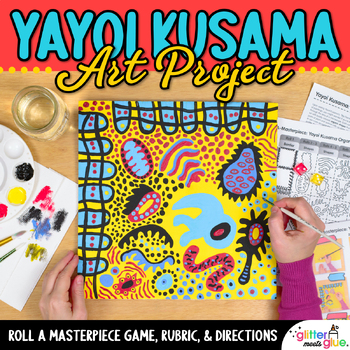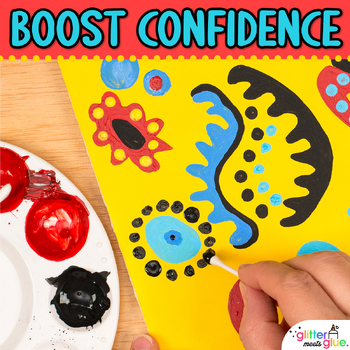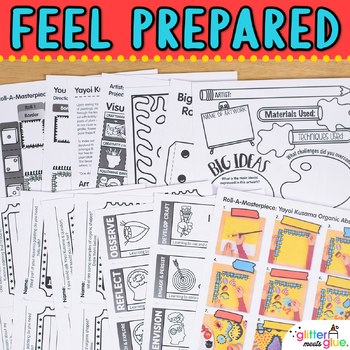Asian Pacific American Heritage Month: Yayoi Kusama Abstract Art Project
- Zip
- Google Apps™
- Easel Activity

What educators are saying
Also included in
- Ready to teach modern art in a way that’ll keep elementary and middle school kids engaged? These 9 roll a dice drawing games based on contemporary artists will boost student confidence and creativity. Each art project comes with a self-guided PowerPoint and printable handout. Perfect art sub plans!APrice $35.99Original Price $45.00Save $9.01
- Looking to weave art history into your elementary and middle school art curriculum? These roll a dice games based on Pop Art, Modern Art, Black Artists, and various cultures will ignite your art lessons. Each engaging art project makes for great art sub plans because they include art worksheets, artPrice $125.99Original Price $175.00Save $49.01
Description
Ready to liven up your middle school art curriculum with engaging Asian Pacific American Heritage Month art projects? This Yayoi Kusama art lesson will boost student confidence and creativity. Kids will be intrigued by her “My Eternal Soul” paintings that look like plant and animal cells. Moreover, they’ll connect with her obsession over dots in her Infinity Mirror Rooms.
And, it’ll help time-starved teachers like you create AAPI lesson plans based on modern artists like Yayoi Kusama.
During this art lesson, your class will learn how she uses bright, flat colors, shallow depth of field, and organic shapes to create her dot paintings. And, they’ll discover where the idea for these works came from. Students will paint an abstract composition with acrylic paints using the step-by-step guide and PowerPoint.
Plan lessons for students about contemporary artists and art appreciation in a way that excites them. Finally feel confident in your art curriculum and be organized and prepared to teach art!
WHAT'S INCLUDED
Can I be honest with you? Art history can sometimes be boring for kids. There, I said it. Teaching about artists and cultures doesn’t have to be a snoozer, though!
I’ve designed 3 different ways for students to attempt this Yayoi Kusama art project. All will engage kids to create! Choose which way works best for your classes:
- Roll a dice game to add randomness to your student’s artwork
- “You Pick” art worksheet for kids to choose their own elements
- Digital spinner wheels, so kids can randomly pick elements and you can integrate technology in the art room
- Printable dice template in case you have no dice
- Step-by-step picture directions to guide students through the art process
- Drawing practice worksheet, for kids who want to sketch out their ideas
- Yayoi Kusama Artist biography about the life and work of this Japanese sculptor and painter, so you don’t need to research
- “Big Ideas” reflection worksheet where students write about their art process
- Self-assessment worksheet so kids can think about how they performed during the project
- Art grading rubric which assesses expectations, craftsmanship, work habits, creativity, and clean-up
- 8 “I CAN” Statements aligned to the Studio Habits of Mind to use during instruction or post on your bulletin board
- 4 Art exit tickets with quick, thought-provoking prompts
- Art history coloring pages to keep kids inspired by Yayoi Kusama’s abstract dot paintings outside of the art room
YOU WILL RECEIVE
- 1 Non-Editable Printable PDF (Yayoi Kusama Art Project)
- 1 Non-Editable PowerPoint
- 5 Digital Spinner Videos (downloadable, and links to them on Google Slides and YouTube)
- Paperless Google Drive Digital Resource
WHY YOU’LL LOVE IT
⭐️⭐️⭐️⭐️⭐️
What a fantastic art lesson! My students absolutely loved creating their organic abstraction paintings and they turned out amazing! Great way to brighten up a bulletin board, for sure. This will definitely be a yearly project for my classes from now on. Thanks so much!
⭐️⭐️⭐️⭐️⭐️
This is a great resource that really hits a lot of content areas. Many of my students had seen a previous local installation by the artist and were really excited to create their own artwork in their style!
⭐️⭐️⭐️⭐️⭐️
My fourth and fifth-grade students are studying art history. As a catch-up day activity, I gave students the option of creating artwork with these roll-an-art worksheets. I love Kusama, so I was pleasantly surprised that you had created a roll-an-art worksheet with her in mind. Thank you for such a great resource!
YOU MAY ALSO LIKE
- Katherine Bernhardt Art Project
- Howardena Pindell Art Project
- Heather Galler Art Project
Created by Amie Bentley, © Glitter Meets Glue Designs, LLC








